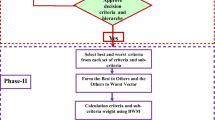Abstract
The evolution of international regulation leads to new capital requirements imposed on globally active companies. Financial services firms allocate capital to business lines in order to withstand the materializing credit losses and to measure the performance of various business lines. In this study, we introduce a methodology for optimal credit capital allocation based on operations research approach. In particular, we focus on the efficient allocation of capital to business lines characterized by credit risk losses and cost of capital. We compare different allocation methods and provide a rationale behind using the OR approach. Finally, we formulate a multiobjective optimization model to capital allocation problem and apply it to a real-world case of two financial conglomerates.




Similar content being viewed by others
Notes
A solution \(Z\in S\) is said to dominate a solution \(Y\in S\) if \(f_i(Z)\le f_i(Y)\, \text{ for } \text{ all }\, i=1,2,\ldots ,m\) and \(f_j(Z)<f_j(Y)\) for at least one index \(1\le j\le m\). Moreover, \(Z\) is said to be not dominated by set \(S\) if there is no solution \(Y\in S\) that dominates \(Z\). In this case, \(Z\) is called nondominated or Pareto-optimal solution. The collection of all Pareto-optimal solutions is called the Pareto-optimal set and the graphical representation of these solutions in terms of their objective function values is called the efficient frontier.
References
Acerbi C, Tasche D (2002) On the coherence of expected shortfall. J Bank Financ 26(7):1487–1503
Artzner P, Delbaen F, Eber J-M, Heath D (1999) Coherent measures of risk. Math Financ 9(3):203–228
Basso A, Peccati LA (2001) Optimal resource allocation with minimum activation levels and fixed costs. Eur J Oper Res 131(3):536–549
BCBSa (2011) Basel III: a global regulatory framework for more resilient banks and banking systems. In: Basel committee on banking supervision. http://www.bis.org/publ/bcbs189.htm
BCBSb (2009) Range of practices and issues in economic capital frameworks. In: Basel committee on banking supervision. http://www.bis.org/publ/bcbs152.htm
Buch A, Dorfleitner G (2008) Coherent risk measures, coherent capital allocations and the gradient allocation principle. Insur Math Econ 42(1):235–242
Cummins DJ (2000) Allocation of capital in the insurance industry. Risk Manag Insu Rev 3(1):7–27
Denault M (2001) Coherent allocation of risk capital. J Risk 4(1):1–34
Dhaene J, Goovaerts MJ, Kaas R (2003) Economic capital allocation derived from risk measures. N Am Actuar J 7(2):44–56
Dhaene J, Tsanakas A, Valdez EA, Vanduffel S (2012) Optimal capital allocation principles. J Risk Insur 79(1):1–28
Erel I, Myers SC, Read JA Jr (2014) A theory of risk capital. Dice Center working paper no. 2009-10, Fisher College of Business working paper no. 2009-03-010
Estrella A (2004) The cyclical behavior of optimal bank capital. J Bank Financ 28(6):1469–1498
FED (2013) Dodd–Frank act stress test 2013: supervisory stress test methodology and results. http://www.federalreserve.gov/newsevents/press/bcreg/dfast_2013_results_20130314
Fonseca RJ, Rustem B (2012) International portfolio management with affine policies. Eur J Oper Res 223(1):177–187
Homburg C, Scherpereel P (2008) How should the cost of joint risk capital be allocated for performance measurement? Eur J Oper Res 187(1):208–227
Kalkbrener M (2005) An axiomatic approach to capital allocation. Math Financ 15(3):425–437
Kolm PN, Tütüncü R, Fabozzi FJ (2014) 60 years of portfolio optimization: practical challenges and current trends. Eur J Oper Res 234(2):356–371
Laeven RJ, Goovaerts MJ (2004) An optimization approach to the dynamic allocation of economic capital. Insur Math Econ 35(2):299–319
Li Y, Zhu S, Li D, Li D (2013) Active allocation of systematic risk and control of risk sensitivity in portfolio optimization. Eur J Oper Res 228(3):556–570
Lin T, Lee C-C, Kuan Y-C (2013) The optimal operational risk capital requirement by applying the advanced measurement approach. Cent Eur J Oper Res 21(1):85–101
Litterman R (1996) Hot spots [TM] and hedges. J Portf Manag 23:52–75
Mausser H, Rosen D (2007) Economic credit capital allocation and risk contributions. Handb Oper Res Manag Sci 15:681–726
McNeil A, Frey R, Embrechts P (2010) Quantitative risk management: concepts, techniques, and tools. Princeton University Press, Princeton
Myers SC, Read JA (2001) Capital allocation for insurance companies. J Risk Insur 68(4):545–580
Overbeck L (2000) Allocation of economic capital in loan portfolios. In: Franke, J, Stahl G, Hrdle W (eds) Measuring risk in complex stochastic systems, vol 147. Lecture notes in statistics. Springer, New York, pp 1–17
Patriksson M (2008) A survey on the continuous nonlinear resource allocation problem. Eur J Oper Res 185(1):1–46
Steuer RE, Na P (2003) Multiple criteria decision making combined with finance: a categorized bibliographic study. Eur J Oper Res 150(3):496–515
Tasche D (1999) Risk contributions and performance measurement. Working paper, Technische Universitaet Muenchen
Tasche D (2004) Allocating portfolio economic capital to sub-portfolios. In: Dev A (ed) Economic capital: a practitioners guide. Risk Books, London, pp 275–302
Tsiakis P, Papageorgiou LG (2008) Optimal production allocation and distribution supply chain networks. Int J Prod Econ 111(2):468–483
Wang W, Plante RD, Tang J (2013) Minimum cost allocation of quality improvement targets under supplier process disruption. Eur J Oper Res 228(2):388–396
Xu M, Hu T (2012) Stochastic comparisons of capital allocations with applications. Insur Math Econ 50(3):293–298
Xu M, Mao T (2013) Optimal capital allocation based on the tail mean-variance model. Insur Math Econ 53(3):533–543
Zaks Y (2013) An alternative proof to Markowitz’s model. J Financ Econ 1(3):33–35
Zaks Y, Tsanakas A (2014) Optimal capital allocation in a hierarchical corporate structure. Insur Math Econ 56:48–55
Author information
Authors and Affiliations
Corresponding author
Additional information
The views expressed herein are those of the authors and not necessarily those of UBS, which does not accept any responsibility for the contents and opinions expressed in this paper.
Rights and permissions
About this article
Cite this article
Mizgier, K.J., Pasia, J.M. Multiobjective optimization of credit capital allocation in financial institutions. Cent Eur J Oper Res 24, 801–817 (2016). https://doi.org/10.1007/s10100-015-0384-9
Published:
Issue Date:
DOI: https://doi.org/10.1007/s10100-015-0384-9




